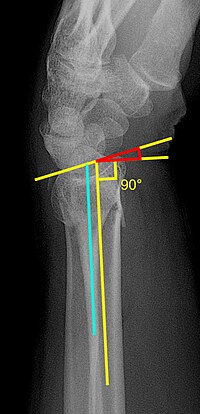
Photo from wikipedia
Objectives: Lisfranc injuries are increasingly common among athletes. Tarsometatarsal joint injuries often damage the articular cartilage and increase predisposition for post-traumatic arthritis and functional deformity of the midfoot. Injury-related morbidity… Click to show full abstract
Objectives: Lisfranc injuries are increasingly common among athletes. Tarsometatarsal joint injuries often damage the articular cartilage and increase predisposition for post-traumatic arthritis and functional deformity of the midfoot. Injury-related morbidity in athletes has substantial consequences such as decreased performance and earlier retirement from sports. While open reduction and internal fixation (ORIF) has been established as the standard of care for unstable Lisfranc injuries, there is currently no consensus regarding the optimal technique for stabilization. Extra-articular fixation has been described as a reasonable technique for Lisfranc joint stabilization due to avoidance of iatrogenic articular disruption and subsequent morbidity. The purpose of this study was to assess the pre- and post-operative patient-reported outcomes of athletes with Lisfranc injuries following ORIF using an extra-articular dorsal locking plate. Methods: Following Institutional Review Board (IRB) approval, data was collected prospectively using an institution-based patient-reported outcomes registry. The registry was queried for patients who had undergone open treatment for tarsometatarsal dislocation (CPT 28615) between April 2015 and August 2018. Medical records were reviewed for the following criteria: athlete, 15 - 45 years of age, Lisfranc injury, ORIF, extra-articular dorsal locking plate, and completion of both pre- and post-operative outcomes surveys. 10 athletes were identified. The surveys used were as follows: VAPS, PASS, PROMIS-M, PROMIS-P, SF12-M, SF12-P, FAAM-ADL and FAAM-Sports. A comparison of pre- and post-operative outcomes was performed using paired t-tests. Statistical significance was defined as a p-value <0.05. Results: 10 athletes (5 male, 5 female) with an average age of 18.2 years were analyzed. Sports included football, gymnastics, soccer, hockey, and basketball. Competition levels included high school and college. All athletes had scheduled hardware removal between 3 - 5 months (average 4.4 months) after the initial ORIF. The FAAM-ADL scores (Δ42.49, p <0.0174) improved significantly at 6-months follow-up. The improvement of FAAM-ADL scores continued to trend positively for up to 1-year post-operatively; however, there was insufficient data to analyze for significance. There was no statistical significance observed between pre- and post-operative VAPS, PASS, PROMIS-M, PROMIS-P, SF12-M, SF12-P and FAAM-Sports scores at 6-months follow-up. 100% of athletes returned to sport at an average of 6 months. Conclusion: In athletes, extra-articular dorsal plate fixation of the Lisfranc joint demonstrates improvement in post-operative patient reports of function. Broad-statistical significance across all patient-reported measures was likely limited due to the number of participants. Patient-reported outcomes may serve as a guide to assess athlete progress during the post-operative period. Further studies are needed to compare the long-term outcomes of Lisfranc injuries in athletes following various methods of fixation.
Journal Title: Orthopaedic Journal of Sports Medicine
Year Published: 2019
Link to full text (if available)
Share on Social Media: Sign Up to like & get
recommendations!